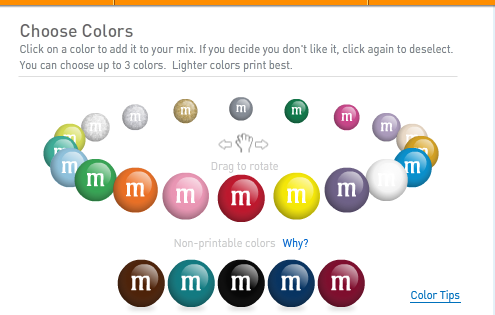Have you ever designed your own, personalized M&M's candies?
It's a pretty neat idea, choose the colors and combinations you like the best, have your own personalized message printed on the candy, have your creation shipped to your door. Sure, it costs a bit more that simply heading over to the grocery store and buying 'standard' M&M's, but you end up with exactly what you want. The end result, while sharing some essential commonality with all other M&M's candy, (they are not changing the recipe for you), has just enough personalization to be simultaneously distinctive and recognizable. The folks at M&M's are able to design for this ability to customize and personalize by carefully controlling just exactly what aspects of the product offering are personalizable, (color selections and messages), and what are not, (size and shape of the product, ingredients).
personalized message printed on the candy, have your creation shipped to your door. Sure, it costs a bit more that simply heading over to the grocery store and buying 'standard' M&M's, but you end up with exactly what you want. The end result, while sharing some essential commonality with all other M&M's candy, (they are not changing the recipe for you), has just enough personalization to be simultaneously distinctive and recognizable. The folks at M&M's are able to design for this ability to customize and personalize by carefully controlling just exactly what aspects of the product offering are personalizable, (color selections and messages), and what are not, (size and shape of the product, ingredients).
By offering this personalization service, M&M's can take some small steps towards making a commodity product into something more, and in so doing, forge closer connections with customers for which this ability to participate in the design of their M&M's is worth the price premium the company requires. At a transactional level, everyone wins.
Increasingly consumers appreciate, and in some markets and product segments, are coming to expect the ability to tailor and customize product offerings. A recent post on the Forrester Consumer Product Strategy blog argues that, 'Current and emerging digital technologies are turbo-charging mass customization, breathing new life into the product strategy', and that 'The time is now for product strategists in all industries to consider adding mass customization – including true build-to-order products – to their product portfolios.'
Forrester then offers a four-step framework that product designers and marketers should consider following in order to ensure that their personalization strategies are both meeting customer's needs, as well as being sustainable, supportable, and profitable for the organizations. You can read the Forrester piece for more details on the framework, but essentially it consists of:
- Determining the context for personalization - what can and can't be defined or altered by the customer.
- Creating a great user experience that allows customers to see and understand their options, and the consequences of selection from among their choices
- Designing to solve a real need, not just the perception of a customer need
- Remaining flexible to adapt to changing conditions, and to predict what customers will want for personalization options in the future
Whether or not Forrester is correct in predicting an increase in product personalization capability through more powerful web technology, and in their advice to organizations to consider pursuing personalization capability more broadly remains to be seen. But if they are right, or at least directionally correct, could there be implications more broadly for organizations, specifically in the design of work and in the value proposition employers make to employees and candidates.
Traditionally employers offer the 'job', the discrete unit of duties, responsibilities, etc. that they expect and require employees and candidates to meet and (mostly) fulfill. The components of the job tend not to vary too much over time, and are generally not particularly malleable or personalizable. In recruiting, organizations tend to match the requirements of the job with the documented and demonstrated capability of the candidate, while considering whether or not the 'gaps' in experience or skills are significant enough to move on to the next candidate. Fail to have enough of the required traits, or even one of the most critical ones, and well, no match. Move on to the next candidate.
We tell candidates that we will keep their resume on file in case something more suited to their skills turns up, but in reality in the majority of circumstances that 'miss' represents their one and only chance.
But what if the organization approached the recruiting and job design process more like our friends at M&M's, and if Forrester is correct, how more and more product marketers will address their markets? What if we could identify for a role, or really a role type, some essential and non-negotiable components or skills (size and shape of the candy), and then a more flexible and fluid set of variables (color, messages), that could be combined to create a more customized, personalized opportunity for the candidates? Might this be a step in addressing the 'skills gap' that might not actually solely a skills gap, but the results of a lack of institutional flexibility?
If a company could figure out a way to do this, they might get the benefit of discovering more committed and engaged candidates and employees (since they had some input into the design of the job), and also to lose less of their really talented candidates and employees because of really kind of slight and relatively unimportant mismatches between skills, interests, and job requirements.
Is it crazy to think organizations could be mature enough in their understanding of workforce capability needs to offer the ability for more personalization in the design of work?
Is it crazy that I can order twelve pounds of orange M&M's that say 'Steve is my hero?'